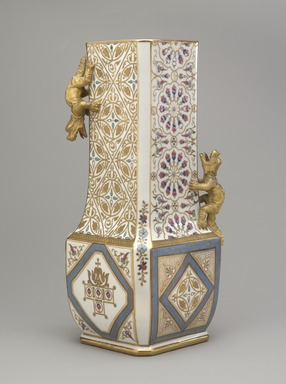Browse

| Accession # | 68.87.44 |
|---|---|
| Manufacturer | Union Porcelain Works |
| Title | Vase |
| Date | ca. 1884 |
| Medium | Porcelain |
| Dimensions | 14 7/8 x 6 1/4 x 6 1/4 in. (37.8 x 15.9 x 15.9 cm) |
| Marks | Printed on underside: partial mark in brown of "UNION / PORCELAIN / WORKS / GREENPOINT / N.Y."; and mark in green, "U.P.W." above head of an eagle Incised into ground (beneath glaze) on underside: "U.P.W. / 1884" |
| Inscriptions | no inscriptions |
| Signed | no signature |
| Credit Line | Gift of Franklin Chace |
| Location | Visible Storage: Case 36, Shelf L (Ceramics) |
| Description | White, hard paste porcelain, embossed with polychrome and gilded decorations. Square-shaped body with slightly bulging contours supported on foot rim, tapers in then rises to form tall squared neck; grotesque lizards in matte gold applied to opposing corners of neck (one near top faces down, one near body faces up). Each side of body and neck covered with stylized jewel work of geometric and foliate patterns in gold, blues, and pinks. CONDITION: Good. |
Curatorial Remarks: Union Porcelain Works (UPW), the most famous and longest lived of the Brooklyn ceramic firms, was established by Thomas Carll Smith after he bought out his partners at the earlier William Boch & Brothers pottery. UPW produced a wide range of wares that appealed to a broad spectrum of consumers: art pottery, porcelain tableware sets, hotel and restaurant ceramics, Parian ware figures, and even elaborately decorated water filters.
In 1874 UPW hired Karl L. H. Mueller (American, b. Germany, 1820–1887) to design special wares for the 1876 Centennial Exhibition in Philadelphia. He created highly original designs that featured unique North American iconography of native animals and scenes of national history that helped UPW distinguish itself from its European competitors.